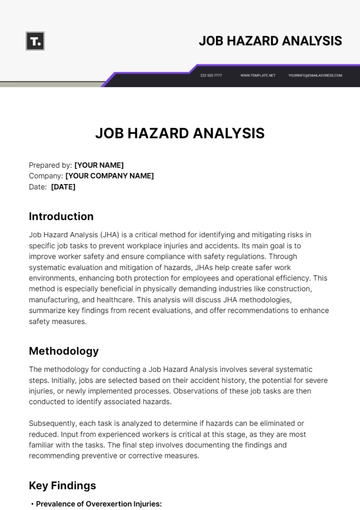Free School Safety Analysis

I. Introduction
Ensuring the safety of students, staff, and visitors is a top priority for [Your Company Name]. This analysis aims to identify potential safety risks and evaluate current security measures to enhance the overall safety of the school environment. Through a comprehensive review of existing protocols, incident reports, and safety equipment, this analysis provides actionable recommendations for improvement.
A. Objectives
Risk Identification: Identify potential safety risks within the school premises, including physical and environmental hazards.
Evaluation of Measures: Evaluate the effectiveness of current security measures and protocols in place.
Recommendations: Provide actionable recommendations to enhance safety and security based on identified risks and evaluation outcomes.
B. Scope
Physical Security: Assess the physical security measures, including surveillance systems, access control, and security personnel.
Emergency Preparedness: Evaluate the school's preparedness for emergencies, including fire drills, lockdown procedures, and emergency communication systems.
Incident Response: Review past incident reports to identify patterns and areas needing improvement in response protocols.
II. Physical Security
A. Surveillance Systems
The following table presents the current state of surveillance systems at [Your Company Name]:
Location | No. of Cameras | Coverage Area | Condition |
|---|---|---|---|
Main Entrance | 4 | Entrance and Lobby | Excellent |
Hallways | 10 | All Hallways | Good |
Classrooms | 20 | Select Classrooms | Fair |
External Grounds | 8 | Playground and Parking | Excellent |
Total | 42 |
Main Entrance: Four cameras cover the entrance and lobby, providing excellent surveillance. This area is critical for monitoring who enters and exits the building, ensuring unauthorized individuals are quickly identified.
Hallways: Ten cameras cover all hallways, maintaining good coverage. Hallway cameras help in monitoring student movement and can deter incidents such as bullying or vandalism.
Classrooms: Twenty cameras are installed in select classrooms, with coverage rated as fair. Classroom surveillance is essential for protecting both students and staff, although the current condition suggests some cameras may need maintenance or replacement.
External Grounds: Eight cameras cover the playground and parking areas, with an excellent condition rating. These cameras are vital for monitoring outdoor activities and ensuring the safety of students during recess or dismissal times.
The total of 42 cameras indicates a robust surveillance system, but the varying conditions suggest the need for regular maintenance checks and upgrades, particularly for classroom cameras. Enhancing the surveillance system by adding more cameras in key areas and ensuring all equipment is in top condition can significantly improve overall security.
B. Access Control
Entry Points: All main entry points are equipped with key card access systems, ensuring that only authorized individuals can enter. These systems are regularly checked for functionality.
Visitor Management: Visitors must sign in at the front desk and receive a temporary badge. This process helps track non-staff and non-student individuals within the school premises.
Lockdown Capabilities: Classrooms and offices have lockdown mechanisms in place, allowing staff to quickly secure doors in the event of an emergency. These mechanisms are tested bi-annually.
C. Security Personnel
Number of Officers: The school employs five full-time security officers who are present during school hours and special events. They are trained in conflict resolution and emergency response.
Patrol Schedules: Security officers conduct regular patrols, covering the entire school premises every hour. This consistent presence acts as a deterrent to potential threats.
Incident Response Training: Security personnel undergo annual training sessions on the latest security protocols and emergency response techniques. This ensures they are well-prepared to handle various situations.
III. Emergency Preparedness
A. Fire Safety
The following table presents the fire safety equipment and procedures at [Your Company Name]:
Equipment/Procedure | Quantity | Condition | Frequency of Checks |
|---|---|---|---|
Fire Extinguishers | 50 | Excellent | Monthly |
Smoke Detectors | 100 | Good | Quarterly |
Fire Drills | Bi-Annual | ||
Emergency Exits | 20 | Excellent | Monthly |
Total | 170 |
Fire Extinguishers: Fifty fire extinguishers are available across the school, all in excellent condition. Monthly checks ensure they are ready for use in case of a fire.
Smoke Detectors: One hundred smoke detectors are installed, with a good condition rating. Quarterly checks help maintain their functionality and ensure early detection of smoke.
Fire Drills: Fire drills are conducted bi-annually to ensure that students and staff are familiar with evacuation procedures. These drills are crucial for preparing the school community for real emergencies.
Emergency Exits: Twenty emergency exits are strategically placed throughout the school, all in excellent condition. Monthly checks ensure they are accessible and not obstructed.
The comprehensive fire safety measures in place, combined with regular checks, significantly reduce the risk of fire-related incidents. Continued diligence in conducting fire drills and maintaining equipment will help sustain a high level of preparedness.
B. Lockdown Procedures
Procedure Manuals: Detailed lockdown procedure manuals are distributed to all staff members. These manuals include step-by-step instructions for various emergency scenarios.
Drill Frequency: Lockdown drills are conducted once per semester to ensure that students and staff are familiar with the procedures. Regular drills help identify any weaknesses in the current protocols.
Communication Systems: The school has an advanced communication system that includes PA systems and text alerts to notify staff and students during a lockdown. These systems are tested monthly.
C. Medical Emergency Preparedness
First Aid Kits: First aid kits are available in every classroom and common area. They are stocked with essential medical supplies and checked monthly.
CPR Training: Staff members receive CPR and first aid training annually. This training equips them with the skills to respond to medical emergencies effectively.
Automated External Defibrillators (AEDs): AEDs are installed in key locations throughout the school. Staff members are trained in their use, and the devices are checked regularly for functionality.
IV. Incident Response
A. Past Incident Analysis
The following table summarizes past incidents reported at [Your Company Name] over the past year:
Type of Incident | No. of Incidents | Severity Level | Follow-Up Actions |
|---|---|---|---|
Bullying | 15 | Moderate | Counseling and Mediation |
Vandalism | 5 | Low | Repair and Deterrence |
Trespassing | 3 | High | Increased Patrols |
Medical Emergencies | 8 | High | First Aid and 911 Calls |
Total | 31 |
Bullying: Fifteen incidents of bullying were reported, categorized as moderate severity. Follow-up actions included counseling for the involved students and mediation sessions to resolve conflicts. Addressing bullying promptly helps maintain a safe and supportive environment for all students.
Vandalism: Five incidents of vandalism occurred, with a low severity rating. Repairs were made quickly, and additional deterrent measures, such as increased surveillance, were implemented. Maintaining the school's physical environment is crucial for student morale and safety.
Trespassing: Three high-severity trespassing incidents were reported. In response, patrols were increased, and access control measures were reviewed and strengthened. Preventing unauthorized access is vital for overall school security.
Medical Emergencies: Eight high-severity medical emergencies were reported, requiring immediate first aid and, in some cases, calls to 911. Having trained staff and readily available medical supplies ensured swift and effective responses.
Analyzing past incidents helps identify patterns and areas for improvement. Regularly reviewing and updating response protocols based on incident reports can enhance the school's preparedness and ability to handle various situations effectively.
B. Incident Response Protocols
Immediate Response: Clear protocols are in place for immediate response to incidents, ensuring swift action by staff and security personnel. These protocols include step-by-step guidelines for different types of emergencies.
Follow-Up Actions: After the initial response, follow-up actions are taken to address the root cause of the incident and prevent recurrence. This may involve counseling, repairs, or policy adjustments.
Documentation: All incidents are thoroughly documented, including details of the event, response actions taken, and outcomes. This documentation is reviewed regularly to identify trends and improve response strategies.
C. Communication During Incidents
Internal Communication: Efficient internal communication channels ensure that all staff members are informed of ongoing incidents and required actions. These channels include PA systems, text alerts, and email notifications.
External Communication: Parents and guardians are informed of significant incidents through automated phone calls and emails. Keeping the school community informed helps manage concerns and maintain trust.
Media Relations: A designated spokesperson handles media inquiries to ensure consistent and accurate information is conveyed. This helps manage the school's public image during and after incidents.
V. Safety Training Programs
A. Staff Training
Annual Safety Training: All staff members undergo annual safety training covering emergency procedures, first aid, and conflict resolution. This training ensures that staff are well-prepared to handle various situations.
Specialized Training: Certain staff members receive specialized training in areas such as crisis intervention and de-escalation techniques. This additional training helps address specific safety concerns more effectively.
New Hire Orientation: Safety training is included in the orientation program for new hires. This ensures that all new staff members are aware of the school's safety protocols from the start.
B. Student Education
Safety Drills: Regular safety drills are conducted for students, including fire drills, lockdown drills, and earthquake drills. These drills teach students how to respond during emergencies.
Safety Workshops: Workshops on topics such as bullying prevention, digital safety, and conflict resolution are held throughout the year. These workshops provide students with the knowledge and skills to stay safe.
Safety Pledges: Students participate in safety pledge programs, where they commit to following safety rules and reporting any concerns. This initiative fosters a culture of safety and responsibility among students.
C. Parent Involvement
Safety Meetings: Regular safety meetings are held with parents to discuss safety protocols and gather feedback. Parental involvement is crucial for reinforcing safety measures at home and in the community.
Safety Resources: Parents are provided with safety resources, such as brochures and online materials, to help them support their children's safety education. These resources cover topics such as internet safety and emergency preparedness.
Volunteer Programs: Parent volunteers assist with safety initiatives, such as monitoring school events and participating in safety drills. Their involvement enhances the overall safety efforts.
VI. Infrastructure and Environmental Safety
A. Building Safety
The following table outlines the key aspects of building safety at [Your Company Name]:
Aspect | Condition | Last Inspection Date | Maintenance Schedule |
|---|---|---|---|
Structural Integrity | Excellent | January 2055 | Annual |
Electrical Systems | Good | March 2055 | Bi-Annual |
Plumbing Systems | Good | April 2055 | Bi-Annual |
HVAC Systems | Fair | May 2055 | Quarterly |
Structural Integrity: The building's structural integrity is rated as excellent, with the last inspection conducted in January 2055. Regular annual inspections ensure that the building remains safe and secure for all occupants.
Electrical Systems: The electrical systems are in good condition, with bi-annual inspections and maintenance. Proper functioning of electrical systems is essential to prevent hazards such as fires or electrical shocks.
Plumbing Systems: The plumbing systems are also in good condition, with bi-annual checks. Ensuring the plumbing systems are well-maintained prevents issues such as leaks or water damage.
HVAC Systems: The HVAC systems are rated as fair, with quarterly maintenance. Efficient HVAC systems are crucial for maintaining a comfortable and healthy indoor environment.
Maintaining the school's infrastructure is critical for ensuring a safe learning environment. Regular inspections and timely maintenance help identify and address potential issues before they become significant problems. Investing in infrastructure upgrades, particularly for the HVAC systems, can enhance overall safety and comfort.
B. Environmental Safety
Playground Safety: The playground is regularly inspected for hazards, such as broken equipment or unsafe surfaces. Any issues are addressed promptly to ensure a safe play area for students.
Hazardous Materials: Proper storage and disposal procedures are in place for hazardous materials, such as cleaning supplies and laboratory chemicals. Staff receive training on handling these materials safely.
Air Quality: Air quality is monitored regularly to ensure it meets health standards. Proper ventilation and air filtration systems help maintain a healthy indoor environment.
C. Safety Signage
Emergency Exits: Clear and visible emergency exit signs are installed throughout the school. These signs help guide occupants to safety during an emergency.
Safety Instructions: Safety instructions are posted in key areas, such as classrooms, laboratories, and cafeterias. These instructions provide guidance on how to respond to various emergencies.
Restricted Areas: Restricted areas are clearly marked to prevent unauthorized access. Signage helps ensure that only authorized personnel enter sensitive areas, such as maintenance rooms and chemical storage areas.
VII. Behavioral and Mental Health Support
A. Counseling Services
Availability of Counselors: The school employs several counselors who are available to support students' mental health needs. Counselors provide individual and group sessions to address various issues.
Crisis Intervention: Counselors are trained in crisis intervention techniques to support students experiencing acute distress. Immediate support is available for students in need.
Referral System: A referral system is in place for students requiring additional mental health services. Counselors work with external providers to ensure students receive comprehensive care.
B. Anti-Bullying Programs
Education and Awareness: Anti-bullying programs educate students about the effects of bullying and promote a culture of respect and inclusion. Regular workshops and assemblies are held to raise awareness.
Reporting Mechanisms: Multiple reporting mechanisms are available for students to report bullying, including anonymous options. These mechanisms ensure that incidents are addressed promptly and confidentially.
Support for Victims: Victims of bullying receive support from counselors and peer mentors. Support programs help students recover from bullying and rebuild their confidence.
C. Peer Support Programs
Peer Mentorship: Peer mentorship programs pair older students with younger ones to provide guidance and support. Mentors receive training to help them assist their peers effectively.
Support Groups: Support groups are available for students dealing with specific issues, such as grief or anxiety. These groups provide a safe space for students to share their experiences and receive support.
Student-Led Initiatives: Student-led initiatives, such as clubs and campaigns, promote mental health awareness and peer support. These initiatives foster a supportive and inclusive school environment.
VIII. Community Involvement
A. Partnerships with Local Authorities
Police Collaboration: The school collaborates with local police to enhance security and address safety concerns. Regular meetings and joint exercises are conducted to improve response times and coordination.
Fire Department Support: The local fire department provides training and resources for fire safety and emergency preparedness. Joint fire drills help ensure effective evacuation procedures.
Health Department Coordination: Coordination with the local health department ensures that health and safety standards are met. This includes regular health inspections and support during health emergencies.
B. Community Programs
Safety Workshops: The school hosts safety workshops for the community, covering topics such as emergency preparedness and personal safety. These workshops help build a safety-conscious community.
Neighborhood Watch: A neighborhood watch program involves parents and community members in monitoring the school area. This program enhances security through increased vigilance and community cooperation.
Volunteer Initiatives: Community members are encouraged to volunteer for safety initiatives, such as monitoring school events and assisting with safety drills. Volunteer involvement strengthens the school's safety efforts.
C. Feedback Mechanisms
Surveys: Regular surveys are conducted to gather feedback from students, staff, and parents on safety concerns and suggestions. This feedback helps identify areas for improvement.
Suggestion Boxes: Suggestion boxes are placed in accessible areas for anonymous feedback on safety issues. These boxes provide a convenient way for the school community to share their concerns.
Public Forums: Public forums are held periodically to discuss safety initiatives and gather input from the community. These forums promote transparency and community engagement in safety efforts.
IX. Conclusion
The School Safety Analysis of [Your Company Name] highlights the strengths and areas for improvement in the current safety protocols. The comprehensive evaluation of physical security, emergency preparedness, incident response, and community involvement provides a clear roadmap for enhancing the school's safety measures. By addressing the identified risks and implementing the recommended improvements, [Your Company Name] can create a safer environment for students, staff, and visitors.
Moving forward, it is essential to maintain regular reviews and updates of safety protocols to adapt to emerging challenges and ensure continuous improvement. Engaging the entire school community in safety initiatives will foster a culture of vigilance and cooperation, ultimately leading to a more secure and supportive learning environment.
- 100% Customizable, free editor
- Access 1 Million+ Templates, photo’s & graphics
- Download or share as a template
- Click and replace photos, graphics, text, backgrounds
- Resize, crop, AI write & more
- Access advanced editor
Analyze campus security with the School Safety Analysis Template! Available on Template.net, this template is customizable to fit your school’s safety analysis needs. Its editable format ensures easy adjustments for specific safety measures. Use the AI Editor Tool to create a thorough and accurate safety analysis, promoting a secure environment!





























